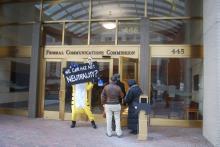
Nearly one year ago on November 15, 2021, Congress passed the Infrastructure Investment and Jobs Act (IIJA), which contained significant legislation around broadband. One piece, which the Institute for Local Self-Reliance (ILSR) has studied closely over the past year and a half, is the implementation of a broadband nutrition label which would require the transparent disclosure of broadband pricing and service information.
While this issue gets very little news coverage, it is an important undertaking as the big providers have a long-established habit of hiding pricing and speed information from subscribers, which prevents them from making informed choices and can leave them vulnerable to exploitation. Our advocacy for the label, and the original research behind our position, can be found here. The FCC is now under deadline to release an order to “promulgate regulations to require the display of” the label by November 15 of this year. We’ve taken a moment here to re-access the issue, offer a few updates, and highlight the ingredients of a strong broadband nutrition label.
Pushing for Clarity, Easy Accessibility, and Enforcement
ILSR, along with 30 other digital equity organizations, recently filed a letter to the FCC supporting the creation of the broadband consumer label and advocating that it be published in a way that makes it clear and easily accessible for customers. While ILSR believes the label is a key decision-making tool and should be published at the point of sale, we reject proposals to limit the label’s display to the point-of-sale only. We emphasize in this letter that the label should also be published on the monthly bill to provide an additional provider accountability mechanism that allows customers to understand what they're paying for.

Another critical piece of a strong label is machine readability, or the availability of aggregate label data in an online database that is accessible to the public. Recent studies – such as those conducted by The Markup and Digital Equity LA, a coalition of more than 40 community-based organizations – have demonstrated the integral role of large datasets in cultivating proper transparency within the broadband market.
The Markup study, for example, “gathered [I]nternet offers from AT&T’s, Verizon’s, EarthLink’s and CenturyLink’s websites for 1.1 million U.S. residential addresses for 45 cities,” and found major discrepancies in available speeds across single pricing tiers. Furthermore, the study found that “In cities where the providers offered different speeds in different areas, the residents living in areas that disproportionately received the worst deals were lower income and people of color, and their neighborhoods had been historically redlined.” An established database would provide the necessary data for third-party organizations to conduct research to serve as the foundation of accountability measures, driving policy and advancing digital equity.
Enforcement of the label is also key. We advocated in our public comments for enforcement mechanisms that will ensure provider compliance, and want to emphasize that these mechanisms must be sustained over the long term. Thus, appropriate resources must be allocated to enforcement not only in the months following the implementation of the label requirements, but also into the future.
We believe requirements and substantive enforcement measures should only worry providers whose offerings are confusing and opaque. Numerous large Internet Service Providers (ISPs) have challenged the label requirements, citing them as imposing significant administrative burden. However, many small providers actually support the label – with some already in compliance.

To further make the point, ILSR’s transparency report, found that municipally-run and cooperative providers are, indeed, more transparent when it comes to service and pricing information compared to what is disclosed by large, private ISPs. In its March comments to the FCC, New America’s Open Technology Institute (OTI) pointed to OpenCape, a small provider interested in using the label to differentiate and promote its budding residential service offering. A number of additional ISPs also filed comments in the broadband label docket underscoring their support for the label. As OTI stresses in its comments, “The Commission should pay close attention to what small ISPs are already doing and look skeptically upon claims that the label would impose unreasonable burdens.”
What’s Next?
The November 15th deadline is rapidly approaching, but the FCC has been entirely silent on the label. As we have reported numerous times, the Senate’s failure to confirm Gigi Sohn for the last seat on the FCC has left the agency in a 2-2 Democratic-Republican split. The deadlock is likely to pose challenges to the implementation of strong broadband label requirements, because disagreement over the label and how it should be implemented falls largely along party lines. ILSR’s Christopher Mitchell explains:
“The Democrats have broadly supported the idea of clear labels to help broadband subscribers better understand what they are paying for and how to compare it to other services. Republicans, on the other hand, prefer to let companies advertise however they prefer and if people are confused, that is their problem.”
- Christopher Mitchell, Institute for Local Self-Reliance
The IIJA is broad in outlining what the FCC order must contain after one year. We advocate not for a strict adherence to the deadline at the expense of strong label requirements, but rather the implementation and enforcement of the label in a way that will ensure real provider accountability. The FCC should not only take careful inventory of the docket, but heed the recommendations of recent research specifically dedicated to identifying customer needs with regards to the label. ILSR recognizes the transparency requirements of the broadband consumer label as a critical opportunity to advocate for Internet users by holding providers accountable to disclosing information properly.
Or, think of it in analogous terms: establishing a broadband connection at home might be likened to filling up a car with gas. The customer has to trust that they are indeed getting the amount of gas indicated on the machine, and it is the government that holds companies accountable so customers do not overpay for what they receive. Similarly, the Food and Drug Administration’s nutrition label ensures that customers are aware of the contents and nutrition information of the food they buy.
Likewise, a broadband label would also function to ensure the customer understands what it is they are paying for before they sign up for service. The label is not an unprecedented and unreasonable ask of providers, but a basic accountability mechanism that is essential to a functioning market for Internet service.
Header image courtesy of Consumer Reports.







